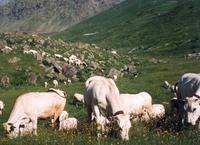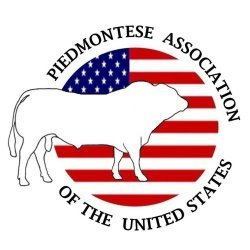Piedmontese History

Breed Origins
Piedmontese have an interesting history that began in the secluded Piedmont region of northwest Italy, an area naturally protected by the Alps mountain range. This area was populated with an ancient European breed of cattle known as Auroch [ Bos Primigenius ]. Descendants of the Aurochs and other domestic European cattle common to the more temperate zones belong to the species of bovine known as Bos Taurus .
Approximately 25,000 years ago another breed of cattle, known as Zebu [ Bos Indicus ], common in tropical areas such as India and Africa, began a massive migration from Pakistan. The trailblazers of this migration where compelled to stop in the valleys of the Piedmont region, taking advantage of the natural Alpine barriers. The Zebu are characterized by a hump of fleshy tissue over the withers that can sometimes weigh as much as 40 to 50 lbs (18.1 to 22.6 kg), a very large dewlap, large drooping ears and a voice that is more of a grunt than a low. While unique in physical appearance, the Bos Indicus family of cattle are hardy animals that have greater resistance to certain diseases and parasites than the descendants of Bos Taurus, allowing them to thrive in areas that make survival difficult for other species of cattle.
These two distinct breeds, the Auroch and the Zebu, blended and evolved in the harsh mountain terrain over thousands of years to become the Piedmontese breed. In 1886, it was the appearance of double-muscling in Piedmontese cattle that attracted the attention of breeders, who had the foresight to recognize the enormous potential of this development. The first Italian Herdbook was opened in 1887 and breeding programs designed to improve the herd and eliminate detrimental aspects associated with double-muscling were put in place.
The Myostatin gene was discovered over one hundred years later. It is this gene, that occurs naturally in all mammals, that restricts muscle growth. However, in the case of Piedmontese cattle, the gene naturally mutated resulting in the unrestricted muscle development known as double-muscling. In fact, muscle development in Piedmontese cattle averages 14 percent higher than in most other breeds. The Myostatin gene also helps to provide the consistent tenderness of Piedmontese beef.
The first Piedmontese animals exported to North America arrived in Saskatchewan, Canada in the fall of 1979. These animals included one bull, BRINDISI, and four females, BANANA, BIBA, BISCA, and BINDA. The following year, five more bulls, including CAPTAIN, CHAMP, CORALLO, CAMINO, and DOMINGO arrived in Canada. Then in the early 1980's five animals were imported from Italy to the United States. These animals included bulls ISTINTO, IMBUTO, and IOSE as well as two cows, INDIA and GAZZA. It was all of these imported animals that served as the original genetic base for the Piedmontese breed in North America.
Piedmontese cattle are Italy's most popular breed and their numbers are growing worldwide. Breeders around the globe including producers in Australia, Brazil, Canada, Denmark, Great Britain, Holland, Mexico, Poland, and New Zealand are actively engaged in breeding Piedmontese cattle.
In 1984 the Piedmontese Association of the United States (PAUS) was organized. In 1987 PAUS incorporated, since then we've recorded over 12,000 animals in our registration database.
Consumers select Piedmontese beef for it's nutritional benefits including lower fat and cholesterol while enjoying a product that is tender and flavorful.

